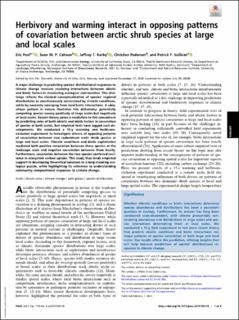| dc.contributor.author | Post, Eric | |
| dc.contributor.author | Cahoon, Sean M. P. | |
| dc.contributor.author | Kerby, Jeffrey T. | |
| dc.contributor.author | Pedersen, Christian | |
| dc.contributor.author | Sullivan, Patrick F. | |
| dc.date.accessioned | 2021-10-20T07:27:08Z | |
| dc.date.available | 2021-10-20T07:27:08Z | |
| dc.date.created | 2021-04-13T15:27:53Z | |
| dc.date.issued | 2021-02-09 | |
| dc.identifier.citation | Proceedings of the National Academy of Sciences of the United States of America. 2021, 118 (6), . | en_US |
| dc.identifier.issn | 0027-8424 | |
| dc.identifier.uri | https://hdl.handle.net/11250/2823986 | |
| dc.description.abstract | A major challenge in predicting species’ distributional responses to climate change involves resolving interactions between abiotic and biotic factors in structuring ecological communities. This challenge reflects the classical conceptualization of species’ regional distributions as simultaneously constrained by climatic conditions, while by necessity emerging from local biotic interactions. A ubiquitous pattern in nature illustrates this dichotomy: potentially competing species covary positively at large scales but negatively at local scales. Recent theory poses a resolution to this conundrum by predicting roles of both abiotic and biotic factors in covariation of species at both scales, but empirical tests have lagged such developments. We conducted a 15-y warming and herbivore-exclusion experiment to investigate drivers of opposing patterns of covariation between two codominant arctic shrub species at large and local scales. Climatic conditions and biotic exploitation mediated both positive covariation between these species at the landscape scale and negative covariation between them locally. Furthermore, covariation between the two species conferred resilience in ecosystem carbon uptake. This study thus lends empirical support to developing theoretical solutions to a long-standing ecological puzzle, while highlighting its relevance to understanding community compositional responses to climate change. | en_US |
| dc.language.iso | eng | en_US |
| dc.publisher | National Academy of Sciences | en_US |
| dc.rights | Attribution-NonCommercial-NoDerivatives 4.0 Internasjonal | * |
| dc.rights.uri | http://creativecommons.org/licenses/by-nc-nd/4.0/deed.no | * |
| dc.title | Herbivory and warming interact in opposing patterns of covariation between arctic shrub species at large and local scales | en_US |
| dc.type | Peer reviewed | en_US |
| dc.type | Journal article | en_US |
| dc.description.version | publishedVersion | en_US |
| dc.rights.holder | © 2021 the Author(s) | en_US |
| dc.source.pagenumber | 9 | en_US |
| dc.source.volume | 118 | en_US |
| dc.source.journal | Proceedings of the National Academy of Sciences of the United States of America | en_US |
| dc.source.issue | 6 | en_US |
| dc.identifier.doi | 10.1073/pnas.2015158118 | |
| dc.identifier.cristin | 1903838 | |
| dc.relation.project | EC/H2020/754513 | en_US |
| dc.source.articlenumber | e2015158118 | en_US |
| cristin.ispublished | true | |
| cristin.fulltext | original | |
| cristin.qualitycode | 2 | |

